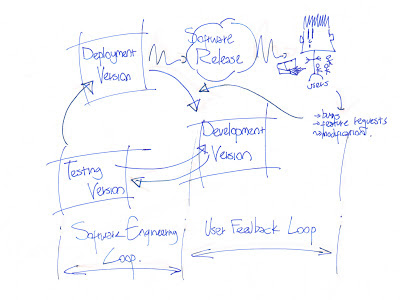Many people tend to associate the logistics term and supply chain management term as synonymous. But, are they really refer to the same concept? In response, I try to cite some statements from a handful of academical papers to confirm this issue. Enjoy!!!
 |
| - my kid's version of supply chain management - |
"Logistics Management: the process of planning, implementing, and controlling the efficient, cost-effective flow and storage of raw materials, in-process inventory, finished goods, and related information flow from point-of-origin to point-of-consumption for the purpose of conforming to customer requirements" (Cooper et. al. 1997).
"Supply chain management is the integration of business processes from end user through original suppliers that provides products, services, and information that add value for costumers." (Cooper et. al. 1997).
“SCM represents one of the most significant paradigm shifts of modern business management by recognizing that individual businesses no longer compete as solely autonomous entities, but rather as supply chains (consisting of individual businesses, working together).” (Lambert and Cooper 2000)
“The term SCM [is] used to explain the planning and control of materials and information flows as well as the logistics activities not only internally within a company but also externally between companies” (Chen and Paulraj, 2004).
“Supply chain management (SCM) encompasses the planning and management of all activities involved in sourcing and procurement, conversion, and all logistics management activities. Importantly, it also includes coordination and collaboration with channel partners, which can be suppliers, intermediaries, third party service providers, and customers. In essence, supply chain management integrates supply and demand management within and across companies”, according to the Council of SCM Professionals (Moonen 2008).
"A review of the SCM literature reveals that confusion exist in terms of what SCM actually is. Nevertheless some commonalities do seem to exist:
- It involves through several stages of increasing intra- and inter-organizational integration and coordination: and in its broadest sense and implementation, it spans the entire chain from initial source to ultimate consumer.
- It potentially involves many independent organizations. Thus managing intra- and inter-organizational relationships is of essential importance.
- It includes the bidirectional flow products (material and services) and information, the associated managerial and operational activities.
- It seeks to fulfill the goals of providing high costumer value with and appropriate use of resources and to build competitive advantages." (Cooper et. al. 1997).
 |
| - end of 2013 - may we always be better persons in many years to come - |
References
Chen, I., & Paulraj, A. (2004). Towards a Theory of Supply Chain Management: the Constructs and Measurements. Journal of Operations Management, 22(2), 119–150.
Cooper, M. C., Lambert, D. M., & Pagh, J. D. (1997). Supply Chain Management: More Than a New Name for Logistics. International Journal of Logistics Management, 8(1), 1–14.
Lambert, D. M., Cooper, M. C., & Pagh, J. D. (1998). Supply Chain Management: Implementation Issues and Research Opportunities. International Journal of Logistics Management, 9(2), 1–18.
Moonen, H. (2009). Multi-Agent Systems for Transportation Planning and Coordination. Erasmus University Rotterdam.



















